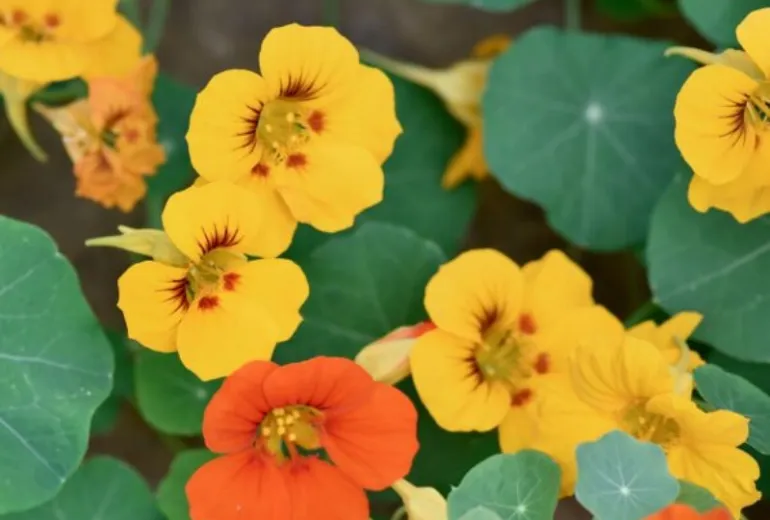The Latin name of the flower comes from the Latin word “trophae” – a small trophy, because of the helmet-like shape of some parts of the flower and its thyroid leaves.
Garden nasturtium, nasturtium, Indian cress or monks cress, has been cultivated for so long in our country that we will be surprised at its American origin. It was brought from Peru, where it is a perennial plant.
In Europe, however, even the weakest frost affects it, and that is why it is grown as an annual plant.
Its seeds are large, self-sow and overwinter well.
It does not like excessively fertilized soil, there the Latina develops excessively lush foliage and blooms less. It likes even humidity and partial shade.
There are also climbing varieties, the stem of which reaches up to 4 m.
It is suitable for decorating walls, fences, walls, gazebos, and the low varieties – for curbs and alleys.
The genus consists of about 50 species; origin South and Central America. The Latin name of the flower comes from the Latin word “trophae” – a small trophy, because of the helmet-like shape of some parts of the flower and its thyroid leaves. Its flowers are simple or dense, with a pleasant aroma, yellow, orange, bright red, red-brown, pink, with a yellow or orange cup.
Garden nasturtium was brought from Peru, where it is a perennial plant, however, even the weakest frost affects it, and that is why it is grown as an annual plant.
A bright and heat-loving plant, it prefers moderately fertile and moist soils (but not calcareous), but does not tolerate either excessive fertilization (especially with nitrogen fertilizers or manure) or excessive watering, especially during flowering. Of them, it blooms worse, it grows only on leaf mass. It needs phosphorus fertilizers. Does not tolerate cold and frost.
Its seeds are large. It is sown directly in the garden at the end of April – the beginning of May, but it is also possible to grow seedlings. In this case, 3 seeds are sown in a pot, and when transplanting them to the permanent place in the garden, keep the soil around the roots.
There are also climbing varieties, whose stem reaches up to 4 m. Wrapping latniks are planted along fences, pergolas or gazebos. Shrubs – in a sunny place, in boxes on the balcony or hanging pots, and low varieties – for curbs and paths. The Latin flower is self-seeding. The seeds ripen 40-50 days after the flowers bloom.
Kinds
Tropaeolum majus – the most widespread species, Tropaeolum cultorum, Tropaeolum peregrinum – creeping (cascading) species – the stem reaches up to 350 cm, strongly cut small leaves, very small and bright yellow flowers with corrugated petals and green spurs. It begins to bloom late.
Compact varieties such as Strawberries and Cream, Peach Melba and Tom Thumb are suitable for growing in cache.
Alaska has medium green leaves with a marble pattern in cream and white.
Description
A beautiful annual flower with a trailing stem that adorns gardens and balconies from summer to frost. Its leaves are light green, thyroid rounded. The flowers have a long spike, are arranged on separate, long stems and are colored yellow-orange with dark purple spots. There are many different variants created. More famous are: Large pearl – with carmine colors. Edra from Nanjing – with orange colors; Chameleon – flowers with a light yellow and brownish red color are formed on the same branch. They are used to decorate terraces, balconies, for flower beds, and the low forms – for borders.
Also used as a cough herb, and its seeds have a laxative effect.
Caring for the Latin flower
It likes sunny and semi-shaded places and sufficient humidification. It also grows well on weaker soil, but with abundant watering.
Place
The homeland of the Latina flower is Central America. Propagation: Latina is propagated by seeds. They are large, three-part and burst when ripe. It is sown in April directly in the permanent place, because it usually does not withstand transplanting.
It starts flowering after about 40-45 days.
Gardener’s tip
The soil of the Latin plant should not be fertilized, because then it only develops leaves.












